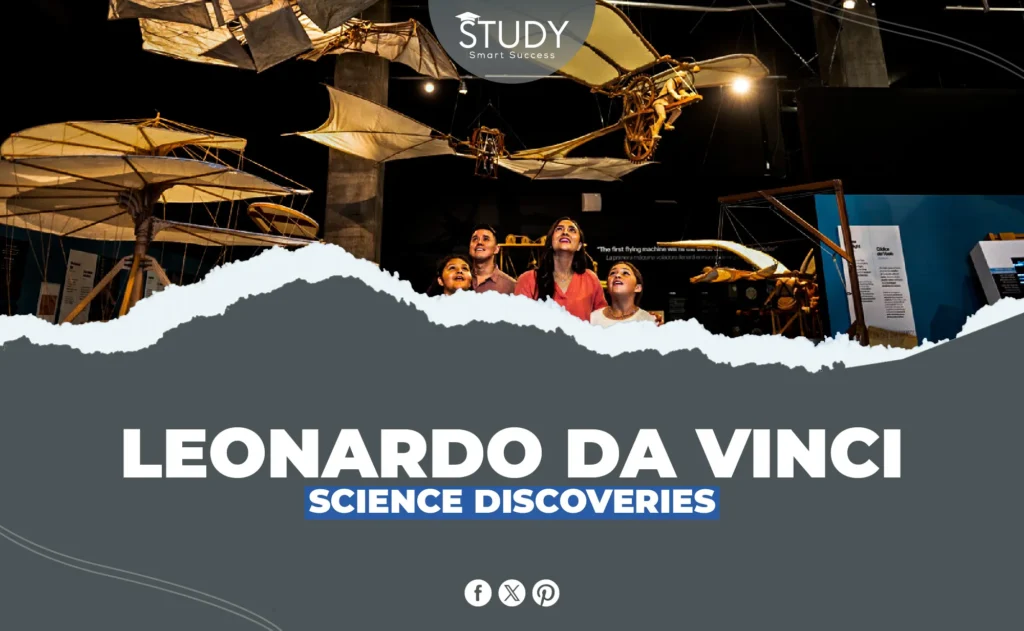Introduction
Famous for his Mona Lisa and The Last Supper, Leonardo da Vinci also devotedly studied and invented. Years ago, he watched, sketched, and tested to develop scientific images and ideas. Leonardo da Vinci science discoveries in anatomy, engineering, and astronomy are remarkable. Explain how his most interesting contributions affected science and art. Read more about different science topics for presentation.
Early Life of Leonardo
April 15, 1452, Leonardo da Vinci was born in Vinci, Italy, close to Florence. Renowned Florentine notary Ser Piero and peasant Caterina produced an illegitimate son. Leonardo had a basic education in reading, writing, and arithmetic from his father’s household. Still, his early observation and curiosity were clear.
At about fourteen, he started a training program with famous Florentine artist and engineer Andrea del Verrocchio. There he polished his mechanical arts, painting, and sculpting skills. Early exposure to numerous disciplines helped open doors for Leonardo’s lifetime curiosity about the junction of art and science.
Leonardo da Vinci Science Discoveries
Anatomy
- Detailed Studies of the Human Body: Leonardo extensively studied human cadavers to investigate their inner workings. His complex anatomical illustrations of muscles, bones, organs, and even the fetus defied modern knowledge. His spine, skull, and heart drawings are still highly regarded for their clarity. Leonardo combined scientific discipline and creative talent to represent the human form’s many qualities in an educational and beautiful way.
- Discoveries in Musculature and Organ Structure: Leonardo demonstrated biomechanical expertise by showing muscle types, functions, and heart anatomy. He established anatomy by showing muscle layers and action. Breakthrough breakthroughs from his heart studies revealed the complex arteries, veins, and ventricular system. His biomechanics and kinesiology studies prepared anatomists and scientists.
2. Optics
- Exploration of Light and Shadow (Chiaroscuro): Leonardo studied light refraction and reflection to perfect chiaroscuro. Mona Lisa and The Last Supper demonstrate how light creates three dimensions. He studied how light flows, interacts with materials, and bounces off objects to create more realistic and compelling paintings. Current optics and light perception in physics and art were impacted by these theories.
- Vision and Perception Studies: Leonardo painted and dissected eyes to study them. He established that binocular disparity and stereoscopic vision create depth perception by giving each eye slightly different images. Leonardo’s early drawings and notes demonstrate visual neurology. His views on the brain’s visual processing function gave scientists a unique look into human perception.
3. Fluid Dynamics
- Observation of Water Movement: Leonardo called water “vetturale di natura,” or nature vessel. Regarding whirlpools, waves, and turbulent water, he portrayed them faithfully. He researched closely how resistance and gravity affect water on surfaces and barriers. Using hydrodynamics and aerodynamics, he observed that water flow patterns matched air motions, therefore proving his fluid behavior understanding.
- The Theory of Eddies and Vortices: Leonardo observed waves and swirls in nature’s water. His precise spirals and circular current drawings predate formal fluid dynamics research and are still fundamental today. He reasoned that varying the pressure and speed could lead to whirling motions. His work started the investigation of fluid motion and its uses in several spheres of science.
4. Engineering and Mechanics
- Concepts for Flying Machines: Leonardo developed several flying machine ideas, including the “ornithopter,” which mechanically flapped its wings to mimic bird flight. His painstaking drawings also featured a parachute and a chopper. However, none of these vehicles were practical with the materials and technologies available then. Still, his ideas motivated interest in aerodynamics and set the theoretical groundwork for later aircraft successes.
- Mechanical Engineering Advancements: Modern mechanical engineering sprang from Leonardo’s concepts and models, which included bearings, pulleys, and gears. Studying these mechanics helped him grasp machine design. Leonardo’s mechanical and robotic interests are shown by his “automaton” ideas—a self-propelled vehicle and a mechanized knight. Opening the field of robotics and automation, he developed autonomous automaton replicas of human and animal behavior.
5. Geology and Paleontology
- Study of Fossils and Earth’s Layers: Leonardo da Vinci researched marine fossils from mountains. This unusual discovery made him doubt the biblical flood fossils and suggest a radical transformation of Earth. Leonardo’s thorough research revealed that the surface of Earth moved gradually over time, implying geological time and establishing geology.
- Erosion and Sedimentation Insights: Leonardo also saw how, over time, water may change a scene. He watched as rivers deposited sediments and sculpted rock to produce strata. Examining sediment accumulation and geological characteristics, his work prepared the field for sedimentology. Leonardo’s remarkable sensitivity to environmental events gave them centuries-ahead knowledge of erosion and sedimentation processes.
6. Botany
- Studies on Plant Growth and Patterns: Leonardo’s remarkable botanical research concentrated on leaves, stalks, roots, and flowers. He studied how nutrients and water move across plant vascular systems and looked at phototropism—how plants grow toward light to acquire energy. Leonardo noted that many living things exhibit the Fibonacci sequence, which he found matched phyllotaxis, leaf geometry, and tree branching patterns.
- Understanding of Tree Rings and Growth: His observations and analyses show a strong awareness of how tree rings show prior climatic conditions, including age and rainy or dry periods. Scientific dating based on tree ring patterns and geochronology might reveal historical environmental conditions and project future ecological changes.
7. Physics and Mathematics
- Explorations in Force, Motion, and Mechanics: Leonardo finds that things speed up as they descend centuries before Newton investigates gravity. He painstakingly recorded his pendulum and air resistance tests on moving objects. His views on friction and the center of gravity affected mechanical engineering and dynamics.
- Mathematical Proportions and the Golden Ratio: Drawn to balance and proportion, Leonardo applied mathematics in science and art. He looked at the Golden Ratio, a naturally occurring mathematical ratio that produces beautiful compositions. His well-known image of the Vitruvian Man shows anatomic knowledge and mathematical perfect human body dimensions. This book shows how he motivated generations of scientists and artists.
8. Astronomy
Leonardo da Vinci saw celestial bodies. He claimed that sunlight bouncing off the Moon’s surface caused its brightness to vary from Earth’s. He also postulated that the Earth reflects light similarly, a groundbreaking idea that helped explain how planets reflect sunlight. This concept foreshadowed planet albedo, which measures reflection.
Furthermore, Leonardo proposed that the Earth and Moon may be part of a wider system of celestial entities. He alluded to the notion of a heliocentric world, which was subsequently confirmed by astronomers such as Copernicus and Galileo. His observations established fundamental notions that spurred future exploration and research of our solar system.
Leonardo’s Legacy
DaVinci’s scientific findings demonstrate his brilliance and versatility. Though he never published his notes, his precise drawings and incisive observations are now widely used in many scientific fields. Leonardo’s influence as an artist, scientist, engineer, and visionary thinker inspired much of modern science, including anatomy and fluid dynamics.
Leonardo’s work teaches us that curiosity and observation are the paths to discovery. In many ways, he exemplifies how art and science may coexist, a timeless lesson from the Renaissance’s greatest thinkers.


